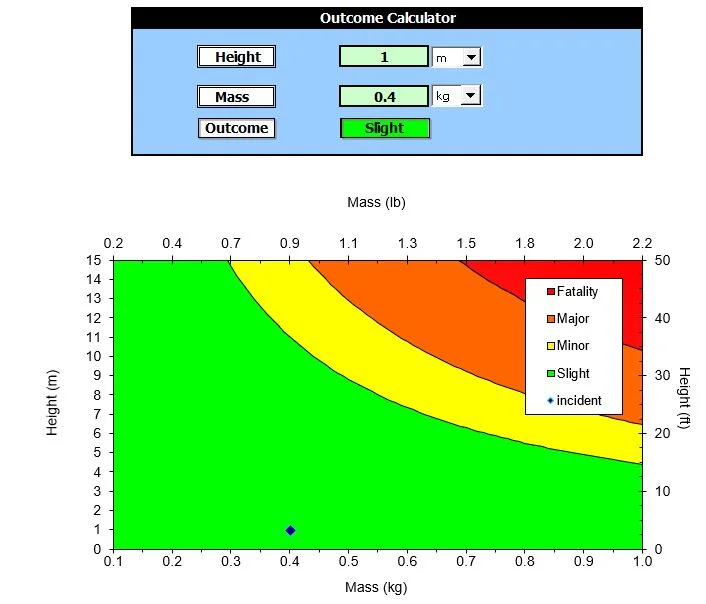A dropped object is defined as ‘any object that falls from its previous static position under its own weight’. If an object falls, the force of gravity will pull it towards the ground and if you happen to be in the way you’ll be hit; it’s as simple as that.
The degree to which you might get injured will be influenced by many factors, but the simple rule of thumb is, the heavier or the further an object can fall, the more damage and injury it can cause. This course will help you identify potential objects, and look at ways to reduce the risk of harm.

Dropped Object Calculator is an electronic excel based calculator for determining the potential consequence of a dropped object.
The Calculator provides a common benchmark in the classification of the potential consequences of a dropped object.

Graph Functionality
For full functionality, please Enable Content where prompted. For information, a single Macro is employed in this workbook to rescale the top Mass(lb) axis where applicable.
Calculator Assumptions
The Calculator assumes that full PPE is being worn and that the object is blunt (no sharp edges the outcome would be worse).
Calculator Accuracy
The Calculator is a guide only and is intended to give a general idea of the potential severity of a dropped object. A detailed and specific risk assessment will always deliver a more accurate calculation of potential severity.
Calculator Key Descriptions
FATALITY
Death resulting from an injury or trauma.
MAJOR
A Lost Time Incident (LTI). Non-fatal traumatic injury that causes any loss of time from work beyond the day or shifts it occurred. Also referred to as Day Away From Work Case (DAFWC).
MINOR
A Recordable Incident. A Work-related injury that does not involve death, day(s) away from work, restricted work or job transfer, and where the employee receives medical treatment beyond first aid.
SLIGHT
A First Aid Case. Limited or no injury. Treatment may be limited to first aid.
Calculating Fall Energey (Joules).
Mass(m) x Height(h) x Gravitational Acceleration(g = 9.82m/s). The Joule is a unit of energy equal to the work done by a force of one newton acting through one meter. In terms of dropped objects, it is recognized that any object achieving 40 Joules or more is likely to result in a recordable (MINOR) incident or worse on impact with a human body. For example, 200g Machine Bolt falling 27m = 53Joules (0.2[m] x 27[h] x 9.82[g] = 53Joules).
Purpose of HSE Dropped Object Consequence Online Calculator
While other ‘calculators’ exist, they all follow the same principle – plotting the mass of a dropped object against the distance it falls to determine its possible consequences.
It is designed to be employed during task planning/risk assessment to determine potential severity rating. It is also used in reporting processes to determine the potential outcome of an actually dropped object incident. It may also be considered during design and manufacture to address requirements for positioning, fixtures, and fittings for items to be secured at height.
Considerations when using HSE Dropped Object Consequence Online Calculator
- With light objects (<0.1 kg) a key influencing factor is the effect of an object punching the skin and damaging tissue/organic functions.
- The calculator assumes a blunt object so is not compatible with broken glass, metal shards, etc.
- The wearing of standard PPE, eg hard hat, safety boots, and eye protection, is assumed in the calculator.
- Do not subtract the height of an individual, measure fall distance to solid deck/ground level.
- DROPS Calculator and other similar tools are guides only providing a cursory indication of the possible outcome – they are not an accurate prediction.
- In reality, even a small object falling from height can be lethal.
Download The Calculator
Dropped Object Consequence Calculator
More Apps
- Downloadable Kitchen Safety Inspection Checklist for Restaurants
- Flammable and Combustible Storage Checklist Free Download
- Ensuring Safety in the Age of Artificial Intelligence: A Comprehensive Review of AI Safety Applications
- Secure Your Lifts:Guidelines for Safe Lifting Operations Free Planning Tool
- Sample of Accident Prevention Program ( APP) Template for General Industry Free Download
- Fire Safety Posters Free Download
- Photo of the day: Preventing Common Kitchen Hazards
- Photo of the day: Safe handling of Gas Cylinders and lecture bottles
- Photo of the day: Forklift Stability Triangle
- Photo of the day: Defective Tools Safe Work Practice
- Photo of the day: Lift With Your Legs Not With Your Back
- Photo of the day: First Aid for burns
- Photo of the day: The 7 Principles of HACCP
- Photo of the day: Working Safely with Suspended Loads
- Photo of the day: Heat Stroke First Aid and safety posters
- Photo of the day: Near-Miss Reporting and Posters
- Photo of the day: Ergonomic chair and office chair safety tips
- Photo of the day: Whole Body Vibration
- Photo of the day: Substation Safety Equipment
- Photo of the day: Bypassing Safety Controls Rules
- Photo of the day: Lightning Safety Tips
- Photo of the day: Overhead Power lines Clearance
- Photo of the day: Floor Marking
- Photo of the day: Types of Foot Protection
- Photo of the day: Types of Hand Protection
- Photo of the day: Confined space safety Precautions
- Photo of the day: Electric shock survival
- Photo of the day: Chemical Spill Emergency Response
- Photo of the day: Construction Site fire Safety
- Photo of the day: Confined Space rescue
- Photo of the day: Conveyors Safety Tips
- Photo of the day: 5 Essential outcomes of an effective leadership survey process
- Photo of the day: Safe Lifting at work
- Photo of the day: 5 Ways to Reinforce Commuting With Positive Reinforcement
- Photo of the day: Eyes on the Road The challenges of safe driving
- Free Safety Slogans
- Photo of the day: Overhead powerline safety
- Photo of the day: Top10 Injuries in office work
- Photo of the day: You can prevent workplace Falls
- Photo of the day: 8 Basic steps to wear a safety harness
- Photo of the day: Ladder Safety Tips
- Photo of the day: Fire Emergency
- Dropped Object Consequence Calculator
- Photo of the day: Most common safety incidents in the workplace
- Photo of the day: Fire Safety checklist for workplace
- Photo of the day: How to Avoid the Fatal Four
- Photo of the day: What is the line of fire
- Photo of the day: workplace Hazards
- Photo of the day: Fostering Engagement at the front line
- Photo of the day: FrontLine supervisors are the LINCHPINS of safety
- Photo of the day:5 keys for effective Self-Management in lone worker safety
- Online Quiz: lightning Safety
- Photo of the day:7 Ineffective Safety Practices (And What To Do Instead)
- Photo of the day:5-Signs your Near-Miss Reporting is failing
- Photo of the day: 10 Elements of Successful Behavior-Based Safety Program
- Photo of the day: Tracking Near Miss Incidents
- Photo of the day: 5 Tips to keep your Crew Healthy and safe at work




